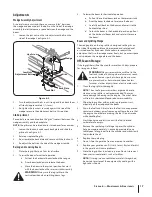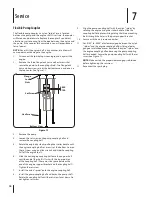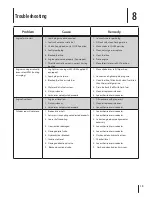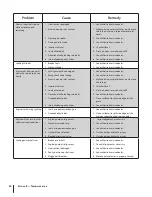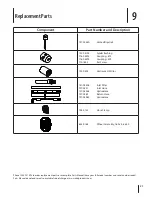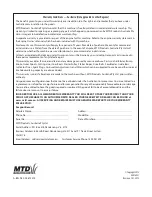
15
S
ection
5 — o
peration
3.
To stabilize the log, place your left hand on the side of the
log opposite the beam as shown in Figure 5-1.
WARNING!
Never place a hand on the ends of the
log, between the log or end plate and the splitting
wedge.
WARNING!
Only one operator permitted. Adult
who loads and stabilizes the log, must be the person
who operates the control handle.
4.
Move the control handle to the forward position to split the
wood.
5.
Remove left hand from the side of the log once wedge just
contacts the log. Continue moving control handle forward
to split the log.
6.
Release the control handle to stop the wedge movement.
7.
Move the control handle to the reverse position to return
the wedge.
8.
To remove partially split wood from wedge, move the
control handle to the REVERSE position until the wedge is
fully retracted to allow split wood portion to contact the
log dislodger.
WARNING!
Never remove partially split wood from
the wedge with your hands. Fingers may become
trapped between the split wood.
9.
Once removed from the wedge with the log dislodger, split
the wood from the opposite end or in another location.
Transporting the Log Splitter
1.
Lower the beam to its horizontal position. Make certain the
beam is locked securely with the horizontal beam lock.
2.
Remove the spring clip and clevis pin from the jack stand.
3.
Support the tongue and pivot the jack stand up against the
tongue. See Figure 5-5.
Spring Clip
Clevis Pin
Figure 5-5
4.
Secure with the spring clip and clevis pin previously
removed. See Figure 5-5.
5.
Attach the coupler hitch to a class I or higher 2” ball on the
towing vehicle; latch securely.
a. If the coupler hitch does not fit on the ball, turn the
adjustment nut one turn counter-clockwise.
b. If the coupler hitch is too loose on the ball, turn the
adjustment nut one turn clockwise. Then recheck
and adjust accordingly.
6.
Connect the safety chains to the towing vehicle.
7.
Plug in the lights to the tail light connector on the tow vehicle.
8.
Move fuel shut-off valve to off position.
WARNING!
Do not tow faster than 45mph and
check the local, state and federal requirements
before towing on any public road.
NOTE:
Use caution when backing up, using a spotter outside the
vehicle is recommended.
Operating Tips
Always:
1.
Use clean fluid and check the fluid level regularly.
2.
Use an approved hydraulic fluid. Approved fluids include
Shell Tellus® S2 M 32 Hydraulic Fluid, Dexron® III / Mercon®
automatic transmission fluid, Pro-Select™ AW-32 Hydraulic
Oil or 10WAW-ISO viscosity grade 32 hydraulic oil. Check
the engine oil level. Refill if necessary.
3.
Use a filter (clean or replace regularly).
4.
Use a breather cap on the fluid reservoir.
5.
Make sure the pump is mounted and aligned properly.
6.
Use a flexible “spider” type coupling between the engine
and pump drive shafts.
7.
Keep the hoses clear and unblocked.
8.
Bleed the air out of hoses before operating.
9.
Flush and clean the hydraulic system before restarting after
servicing.
10.
Use “pipe dope” on all hydraulic fittings.
11. Allow time for the engine to warm-up before splitting wood.
12. Prime the pump before initial start-up by turning over the
engine with the spark plug disconnected.
13. Split wood along the grain (lengthwise) only.
Never:
1.
Use when fluid is below 20° F (-7° C) or above 150° F (65° C).
2.
Use a solid engine/pump coupling.
3.
Operate through the relief valve for more than five (5) seconds.
4.
Attempt to adjust unloading or relief valve settings.
5.
Operate with air in hydraulic system.
6.
Use Teflon tape on hydraulic fittings.
7.
Attempt to cut the wood across the grain.
8.
Attempt to remove partially split wood from the wedge
with your hands. Fully retract the wedge to dislodge wood
with the log dislodger.
Summary of Contents for RM 33 LS
Page 22: ...Notes 10 22...
Page 23: ...23 Section 10 Notes...

















